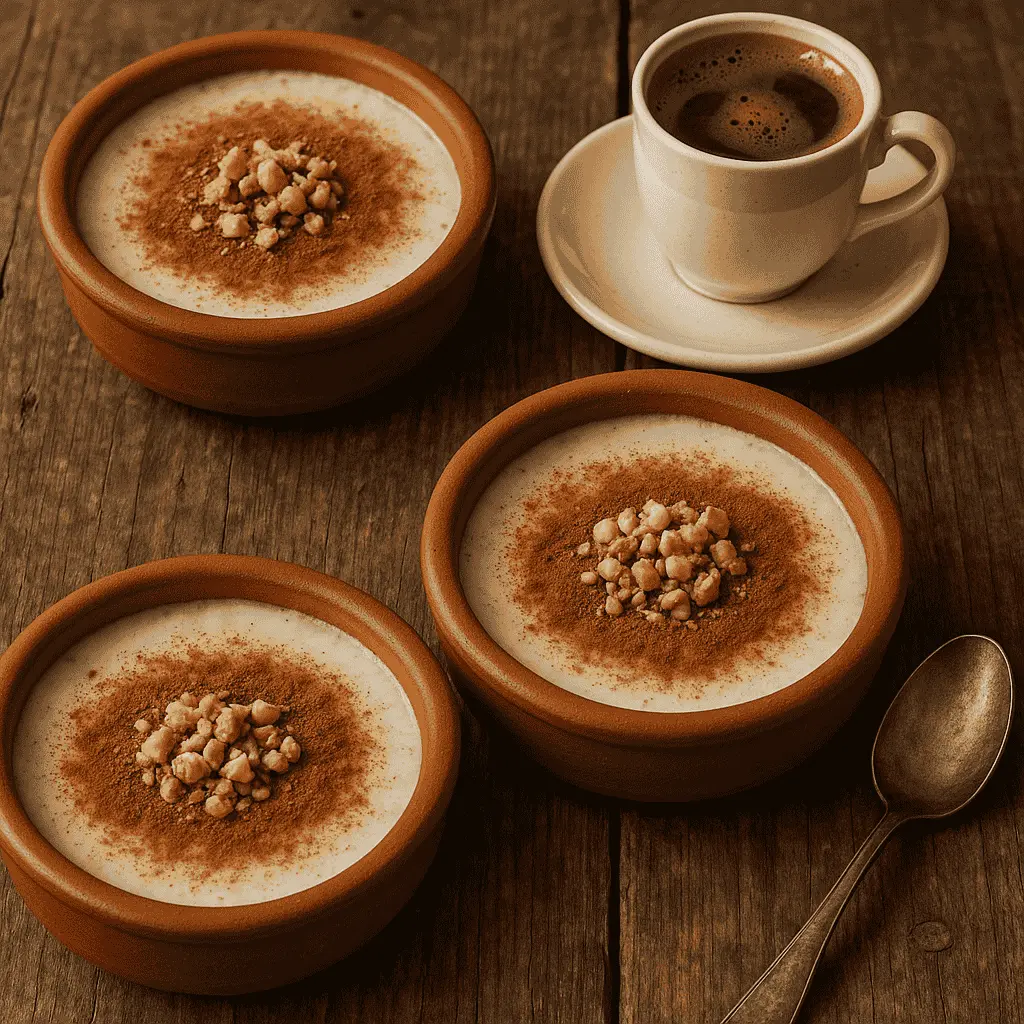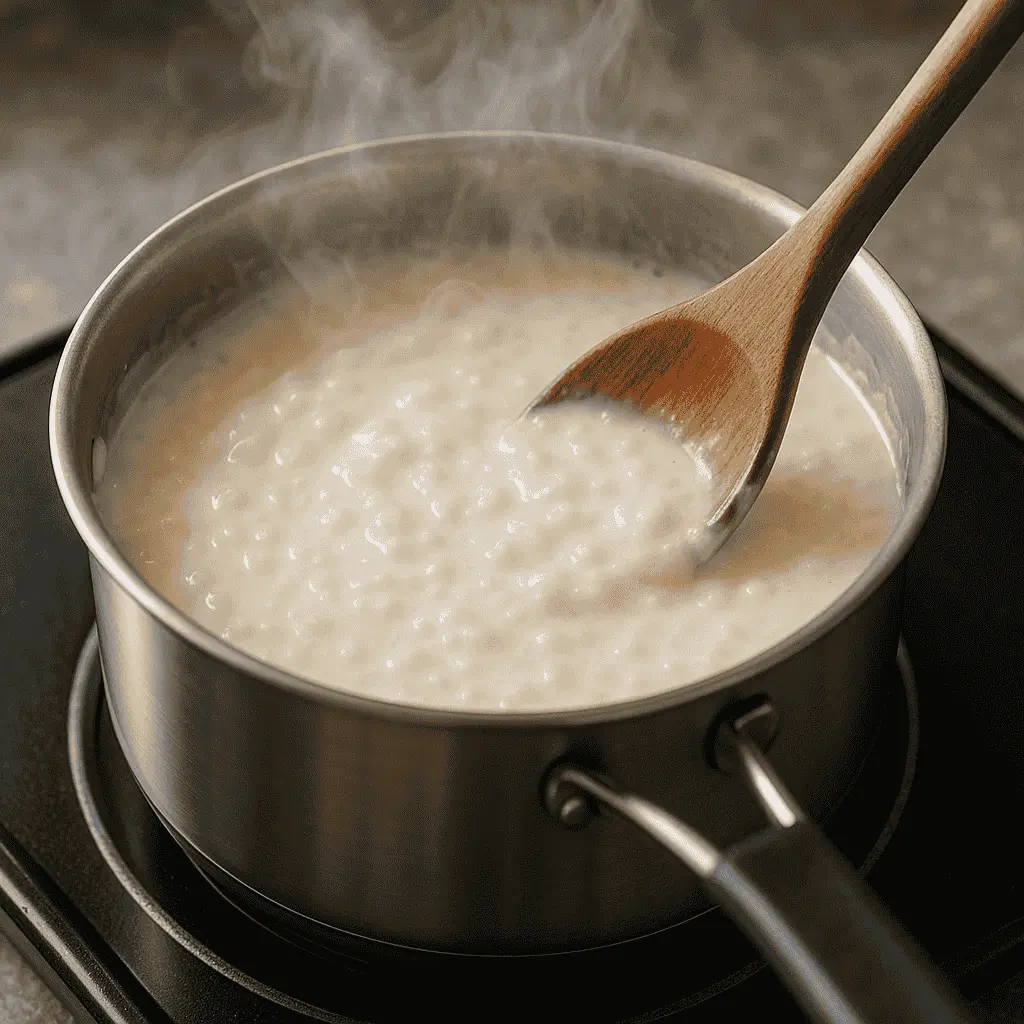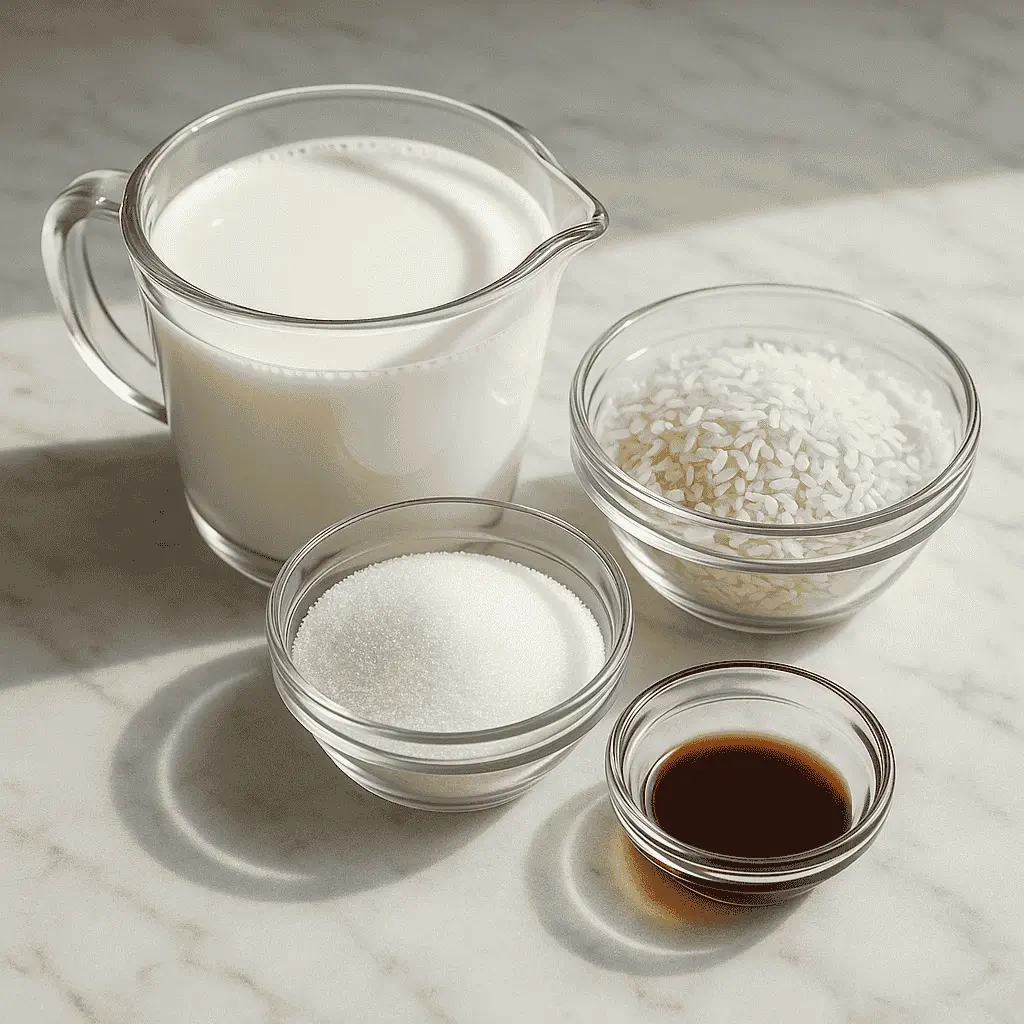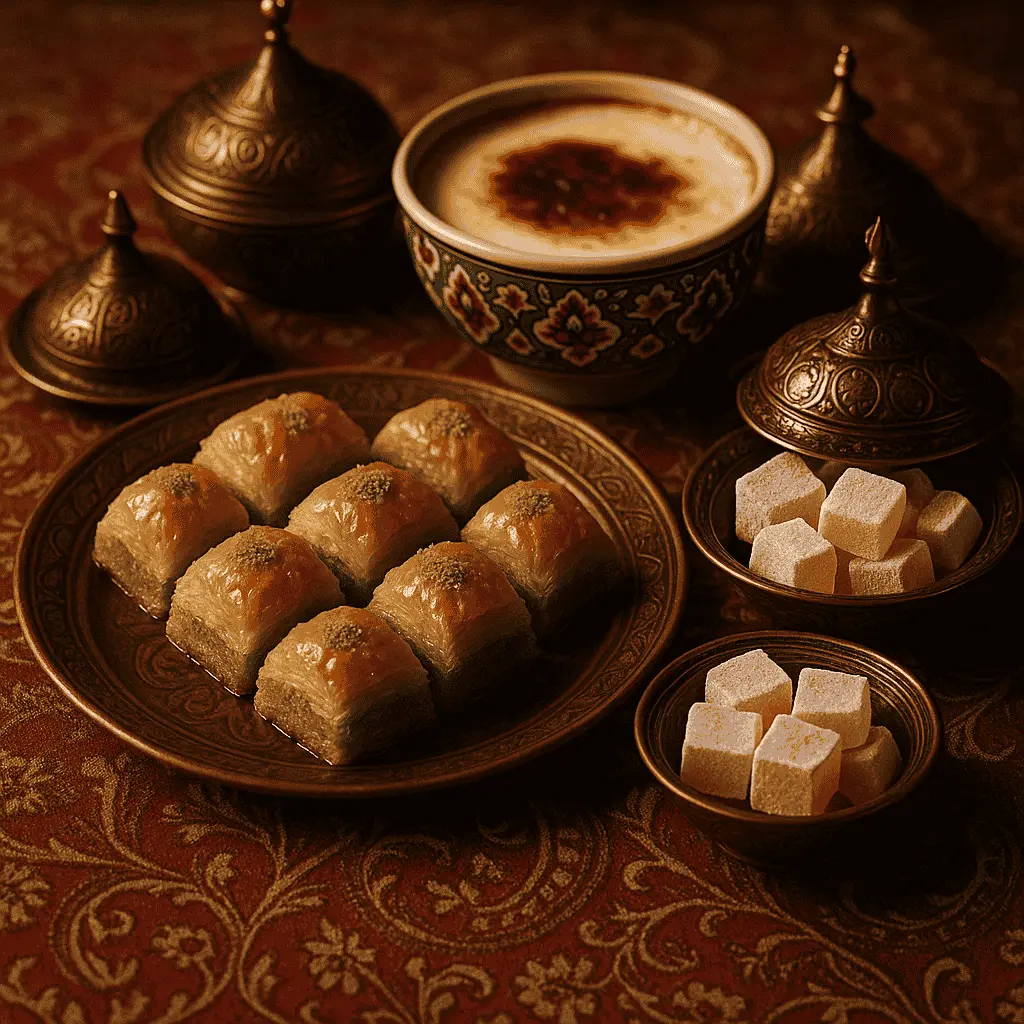Turkish cuisine desserts are proof that flavor doesn’t need to be complicated. I didn’t grow up in the kitchen or with a love for baking. In fact, I used to believe desserts were reserved for expert pastry chefs or people with endless free time. But everything changed the night I whipped up a 15-minute meal from leftovers and realized food could be fast, simple, and still feel special. That moment led to perfectsrecipe.com, where I now share dishes that celebrate both simplicity and taste. Turkish desserts, with their few ingredients and rich traditions, are exactly the kind of magic I live for.
Print
Turkish Cuisine Desserts: The Sweet Flavors You Need to Try
- Total Time: 30 minutes
- Yield: 4 servings 1x
- Diet: Vegetarian
Description
Sütlaç is a creamy Turkish rice pudding made with a few simple ingredients. It’s light, subtly sweet, and perfect as a comfort dessert or a cultural treat.
Ingredients
4 cups whole milk
1/2 cup short-grain rice
1/2 cup sugar
1 tbsp cornstarch (optional)
1 tsp vanilla extract
Instructions
1. Rinse and cook rice in 1 cup water until soft.
2. Add milk and sugar. Stir and simmer for 10–15 minutes.
3. Dissolve cornstarch in 2 tbsp milk (if using), then add.
4. Stir until mixture thickens slightly.
5. Add vanilla, pour into bowls, and let cool.
Notes
For baked sütlaç, broil bowls until tops are golden.
Top with cinnamon, crushed nuts, or dried fruit.
Use rose water for a floral twist.
- Prep Time: 5 minutes
- Cook Time: 25 minutes
- Category: Dessert
- Method: Stovetop
- Cuisine: Turkish
Nutrition
- Serving Size: 1 bowl
- Calories: 210
- Sugar: 18g
- Sodium: 65mg
- Fat: 6g
- Saturated Fat: 3.5g
- Unsaturated Fat: 2.5g
- Trans Fat: 0g
- Carbohydrates: 32g
- Fiber: 0.5g
- Protein: 5g
- Cholesterol: 20mg
Table of Contents
Table of Contents
Sweet Memories & Cultural Origins
I still remember the night I first tasted Turkish delight. I was sitting on a worn cushion in a friend’s apartment in Istanbul, a tiny cube of sugar-dusted lokum melting slowly on my tongue. Its floral notes, soft chew, and unexpected pistachio crunch were unlike anything I had tried before. That moment changed how I saw desserts not just as sweets, but as stories wrapped in flavor. And that’s the thing about Turkish cuisine desserts: they aren’t just made to taste good, they’re made to mean something.
Back then, I wasn’t the guy behind a recipe site. I was just Jack, a curious traveler who didn’t grow up cooking. But discovering desserts like baklava, aşure, and künefe opened my eyes to the magic of simple ingredients transformed by history. These desserts didn’t rely on complicated techniques or fancy tools. They were rooted in tradition, made with care, and shared with love.
Turkish cuisine desserts often trace back to the opulent kitchens of the Ottoman Empire. Sweets were a central part of court life, offered as symbols of hospitality and even political diplomacy. Baklava, for instance, was once gifted to Janissary soldiers during Ramadan. Meanwhile, humble desserts like sütlaç (Turkish rice pudding) and revani (semolina cake) were and still are mainstays in everyday Turkish homes, often flavored with rose water or lemon zest for a refreshing twist.

Like many Asian cuisine dessert traditions, Turkish sweets balance richness and subtlety. And similar to what I later explored with healthy dessert recipes, they often use natural sweeteners like fruit, honey, or molasses.
Today, I create and share these recipes not because they’re exotic or trendy, but because they’re timeless. They remind us that dessert can be as much about connection as it is about indulgence. Turkish cuisine desserts aren’t just food they’re celebration, heritage, and comfort served on a plate.
The Most Beloved Turkish Cuisine Desserts
Turkish cuisine desserts offer a sweet snapshot of centuries-old tradition, and no dessert carries more fame or more flaky layers than baklava. Ask anyone, what is the most popular dessert in Turkey? and you’ll almost always hear baklava. It’s made by stacking delicate sheets of phyllo dough, brushing them with butter, and layering them with crushed pistachios or walnuts before baking and soaking the whole pan in sugar syrup. Crispy on top, sticky and soft in the center, it’s the kind of dessert that doesn’t just satisfy it stuns.
But baklava is just the beginning.
What is the traditional Turkish dessert called? The answer depends on who you ask and where you are. In the southeastern city of Gaziantep, it’s definitely baklava. But in Hatay, you’ll be told it’s künefe a golden nest of shredded pastry called kadayıf, filled with melty cheese and drenched in syrup. Served hot and bubbling, künefe hits both creamy and crunchy notes in a single bite.
Lokum, better known as Turkish delight, is another iconic sweet. It’s soft, fragrant, and often laced with rosewater or citrus, then dusted with powdered sugar. It’s served in homes as a gesture of hospitality or paired with strong Turkish coffee for contrast.
Then there’s aşure, or Noah’s Pudding, a lesser-known but deeply symbolic dessert made from grains, nuts, and dried fruit. Traditionally served during the Islamic month of Muharram, it’s a dish that brings people together and reflects the communal spirit of Turkish food culture.
Turkish desserts are a rich tapestry, like Filipino desserts in their diversity, but unique in how they tie to regional identity. Just like choosing the right seafood seasoning can elevate a savory dish, understanding the story behind these sweets brings them to life.
Underrated Turkish Dessert Recipes to Try at Home
While classics like baklava and künefe get most of the spotlight, there’s a whole world of underrated Turkish cuisine desserts worth discovering and cooking in your own kitchen. One of the most surprising? Ağlayan Kek, or Turkish crying cake.

Now, why is it called Turkish crying cake? The answer’s in the layers. After baking a rich chocolate cake base, it’s soaked with milk, then topped with whipped cream and finally a generous layer of melted chocolate ganache. As the ganache cools, it slowly seeps down the sides like tears. The result is a moist, dramatic dessert that tastes like a cross between a brownie, a milk cake, and a truffle. It’s beloved at birthday parties, coffee breaks, and weekend family tables across Turkey.
But that’s just one slice of what Turkish kitchens have to offer. Turkish cuisine desserts
Another deeply satisfying treat is sütlaç, the Turkish take on rice pudding. Unlike the dense Western version, sütlaç is lighter, silkier, and often baked until the top is slightly caramelized. Flavored with just a touch of vanilla or cinnamon, it’s a dessert that proves simple can still be sublime.
Then there’s revani, a semolina-based cake soaked in lemony syrup. Light, airy, and a breeze to make, revani is often served chilled and cut into diamonds. It’s perfect for summer evenings or when you need to serve something elegant with minimal effort. Turkish cuisine desserts
These under-the-radar Turkish cuisine desserts don’t just satisfy your sweet tooth they fit right into the real-life cooking style we believe in at Perfect’s Recipe. They’re easy, nostalgic, and rich with flavor, much like how bold blackened seasoning transforms seafood, or how a great seafood boil unites simple ingredients in powerful ways.
Make Your Own Turkish Dessert – Full Recipe Included
If you’re ready to bring the flavors of Turkish cuisine desserts into your kitchen, sütlaç (Turkish rice pudding) is the perfect place to start. It’s creamy, comforting, and made with just a few ingredients you probably already have. This recipe captures the heart of traditional Turkish home cooking simple, soothing, and rich with cultural warmth.

Ingredients :
| Ingredient | Quantity |
|---|---|
| Whole milk | 4 cups |
| Short-grain rice | 1/2 cup |
| Sugar | 1/2 cup |
| Cornstarch (optional, for thickness) | 1 tbsp |
| Vanilla extract | 1 tsp |
Steps to Make It:
- Rinse and cook rice in 1 cup of water until soft and water is absorbed.
- Add milk and sugar, stir over medium heat. Simmer 10–15 minutes.
- If using cornstarch, dissolve in 2 tbsp milk, add to pot, and stir until thick.
- Stir in vanilla, then pour into bowls. Cool to room temperature.
- Optional: bake under broiler to caramelize tops like classic sütlaç.
Top it with cinnamon, crushed hazelnuts, or even a dash of pink salt for a mineral-rich twist. It’s a dessert you’ll come back to again and again.
And like many of our main dishes at Perfect’s Recipe, sütlaç proves that cooking well doesn’t mean cooking complicated.
For more information follow me in Medium and Pinterest
Conclusion
Turkish cuisine desserts prove that tradition and taste can live in every spoonful. Whether you’re savoring a flaky piece of baklava, digging into a creamy bowl of sütlaç, or cutting into a rich crying cake, you’re not just eating you’re experiencing culture. These recipes are built for real life: minimal ingredients, maximum flavor, and a story in every bite. That’s what Perfect’s Recipe is all about. Whether you’re just starting out in the kitchen or looking to explore something new, Turkish desserts are a delicious reminder that good food doesn’t have to wait. Let’s keep cooking sweetly and simply.
FAQ: About Turkish Cuisine Desserts
What is the most popular dessert in Turkey?
Baklava holds the crown as the most popular dessert in Turkey. Made with layers of buttery phyllo dough, crushed pistachios or walnuts, and sweet syrup, baklava is a staple at celebrations, holidays, and everyday tables alike. It’s not just delicious it’s part of Turkey’s cultural identity.
Turkish cuisine desserts
What is the traditional Turkish dessert called?
While there are many traditional Turkish desserts, the most widely recognized include baklava, künefe, and lokum (Turkish delight). Each region has its own favorites, making the answer rich with variety.
Turkish cuisine desserts
What is the traditional sweet of Turkey?
Lokum, also known as Turkish delight, is one of Turkey’s most iconic traditional sweets. It’s soft, chewy, and often flavored with rosewater, pomegranate, or citrus. It’s usually served with Turkish coffee as a symbol of hospitality.
Turkish cuisine desserts
Why is it called Turkish crying cake?
Turkish crying cake, or ağlayan kek, gets its name from how the ganache topping appears to “weep” down the sides of the cake. The rich chocolate topping slowly seeps into the soft base, creating a glossy, dramatic finish that looks like tears hence the name.
Turkish cuisine desserts
What is the best Turkish cuisine dessert?
The best Turkish cuisine dessert depends on what you’re craving. If you love crispy and sweet, go for baklava. Want something creamy and comforting? Sütlaç is a perfect pick. Prefer fruity and chewy? Lokum is your answer. Each dessert brings a unique texture and story to the table.
Turkish cuisine desserts
